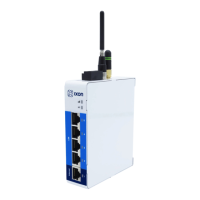18
Electrostatic discharge immunity test
EN 61000-4-3:2006 + A1:2008 +
A2:2010
Radiated, Radio-frequency, Electromagnetic Field
Immunity Test 80-1000 MHz
EN 61000-4-5:2014 + A1:2017
Immunity to Conducted Disturbances, Induced by
Radio-frequency Fields
IEC 60950-1:2006 + A1:2009 +
A2:2013
Information Technology Equipment Safety, Part 1:
General Requirements - Edition 2
Audio/video, information and communication
technology equipment - Part 1:
Safety requirements
Restriction of the use of certain hazardous substances
(RoHS) in electrical and
electronic equipment
Information Technology Equipment Safety, Part 1:
General Requirements - Edition 2
CSA C22.2 No. 60950-1-07 +
Amendment 1 and Amendment 2
Information Technology Equipment Safety, Part 1:
General Requirements - Edition 2
6.4 FCC compliance
The base equipment (an unintentional radiator) has been tested and complies with the limits for a Class B digital
device, pursuant to part 15 of the FCC rules. These limits are designed to provide reasonable protection against
harmful interference in a residential installation. This equipment generates, uses, and can radiate radio frequency
energy and, if not installed and used in accordance with the manufacturer's instruction manual, may cause
interference with radio and television reception.
However, there is no guarantee that interference will not occur in a particular installation. If this equipment does
cause harmful interference to radio or TV reception, which can be determined by turning the equipment off and
on, the user is encouraged to try to correct the interference by one or more of the following measures:
● Reorient or relocate the receiving antenna.
● Increase the separation between the equipment and the receiver.
● Connect the equipment into an outlet on a circuit different from that to which the receiver is connected.
● Consult the dealer or an experienced radio/TV technician for help.
The IXrouter3 contains different FCC certified modules, depending on the variant.
Notice
Changes or modifications of this equipment not expressly approved by the party
responsible for compliance could void the user’s authority to operate the equipment.

